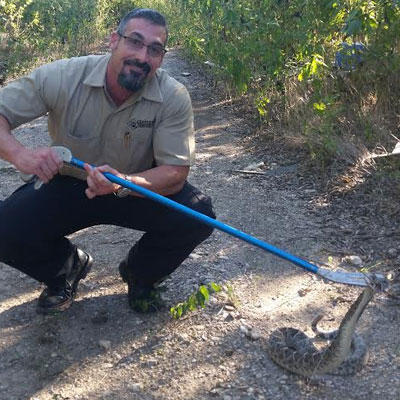Snake Removal
Snakes are some of the most dangerous animals to trap and control. This is because there are 600 known species of venomous snakes in the world. North America is home to (20) species of snakes that are venomous, and all 48 contiguous states have at least one species
Where do venomous snakes live?

In the United States, most venomous snakes reside in warm climates, favoring states like Florida and Texas. Statistics show very few snake bites in the Northern United States as whole, but rare cases of death by snakebite have occurred as far north as Maine.
The good news is that on average, only about 5 people out of the 7,000-8,000 people that are bitten by snakes experience fatal venoming. Of the fatal venomings, a good number come from anaphylactic shock due to the bite, or cardiac arrest–both brought on by the venom. Nearly all hospitals carry anti-venom for venomous snakes, so the threat of death by venomous snake bite is considerably reduced in the United States.
Snakes try to avoid open spaces as much as possible to remain undetected by potential predators.
What to do if you're bitten by a snake?
Snake bites are not something to ignore. If you suspect you were bitten by a snake and did not see it, or are not able to identify it, you should still seek medical attention. You should not try to suck the venom out yourself or allow anyone else to. Do not try to kill the snake or capture it to take it with you to the hospital. If you can, take a photo of the snake and hurry to the hospital or other medical care facility. Under no circumstances should you try to use alcohol to clean the wound or imbibe alcohol, as it will thin the blood and allow the venom to spread faster. While it is commonplace in hollywood films and television, you do not need to use a tourniquet to try to stop blood flow. The person who is bitten should try to be as calm as possible to slow the heart rate.
Snake trapping basics
Snakes can be trapped in several types of store-bought traps, by using tools that grab the snake from a distance, or with your bare hands. We don't recommend that amateurs do any of this. If you encounter a snake in your home, the best thing you can do is grab a broom and try to move the snake into an enclosed area, and call for a professional to remove it.
If your pool is not inside of an enclosure, you have a much higher risk of finding snakes on your pool deck or in the water.
Snake box traps
Box style traps are usually thin, flat boxes with bait and glue on the inside, and two open ends that are perpendicular to the ground. The snake is able to slither in and search for the bait, but quickly realizes that the glue trap has them stuck inside.
Minnow traps for snakes
Hobbyists and trappers like to use snake traps out in wilderness areas to capture snakes. Their effectiveness in homes and business isn't well-documented, but they are extremely effective when used properly. A minnow trap is used to catch a wide range of wildlife because it is simple and effective. The structure of a minnow trap appears to be two mesh cylinders with openings on each end. Each has a small opening at the end of a funnel-shape, and a wide, open end. They clasp together at the wide, open ends, usually with bait like a fresh egg inside. A snake will travel down the funnel to its narrow end and enter the small hole to get to the egg. Once inside, the snake is disoriented and does not know how to find the small hole that it entered through.
